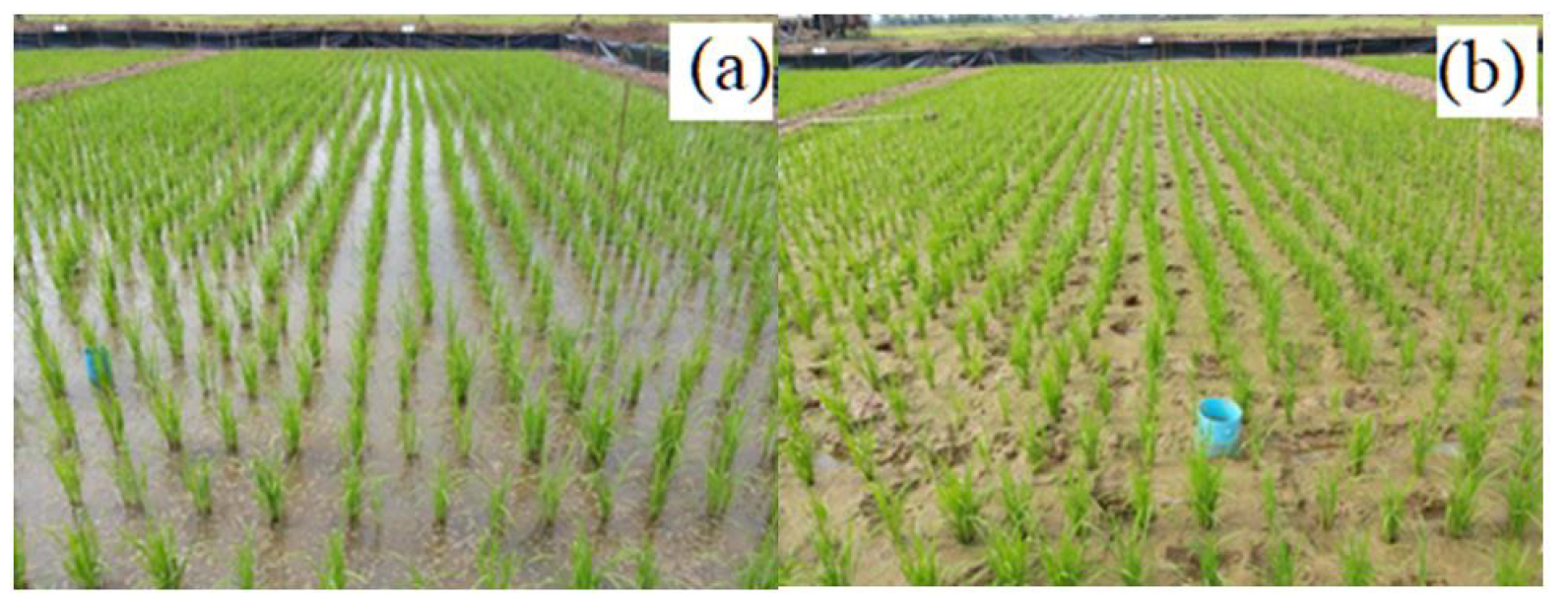Evaluation of water footprint of Phitsanulok-2 rice yield under alternate wetting and drying cultivation in dry season
Main Article Content
Abstract
The objective of this research was to assess the Water Footprint (WF) of rice cultivation in Phitsanulok Province, Thailand. In this research, the data were collected by the field research technique in order to access WF in the rice fields for water saving without affecting the yield using Phitsanulok-2 rice. The implementation of two water management strategies under Alternate Wetting and Drying Method (AWD) was tested in comparison with Continuous Flooding Method (CF). The experiment was conducted during the dry season in 2016 and 2017 in the irrigated fields of Irrigation Water Management Experiment Station (Phitsanulok). From the results, it was found that the water delivery to the plots with both AWD techniques used less water than the continuous water supply method at approximately 33.64% in 2016 and about 18.26% in 2017 in the dry seasons and maintaining grain yield. The average WF of AWD1, AWD2 and CF was 883.35 m3/ton, 912.90 m3/ton and 1,150.45 m3/ton of paddy, respectively. Therefore, the less water cultivation by AWD1 and AWD2 are the appropriate water management strategy for cultivation of irrigated rice and it is an effective way to reduce WF of water used in the agricultural sector for Thailand.
Article Details
References
S. I. Bhuiyan, Water management in relation to crop production: case study on rice, Outlook on Agriculture, 21(4) (1992) 293 -- 299.
T. P. Tuong, B. Bouman, Rice production in water-scarce environments, In: J. W. Kijne, R. Barker, D. Molden (Eds.), Water Productivity in Agriculture: Limits and Opportunities for Improvement, CABI Publishing, 2003.
Office of Agricultural Economics, Agricultural Statistics of Thailand 2016 (Thailand), Bangkok, Thailand, 2017.
B. Dong, D. Molden, R. Loeve, Y. H. Li, C. D. Chen, J. Z. Wang, Farm level practices and water productivity in Zhanghe Irrigation System, Paddy and Water Environment 2 (2004) 217 -- 226.
H. Y. Liu, S. Hussain, M. M. Zheng, S. B. Peng, J. L. Huang, K. H. Cui, L. X. Nie, Dry direct seeded rice as an alternative to transplanted-flooded rice in Central China, Agronomy for Sustainable Development 35(1) (2015) 285 -- 294.
A. Y. Hoekstra, A. K. Chapagain, M. M. Aldaya, M. Mekonnen, Water footprint manual state of art 2009, Water footprint Network, Netherlands, Earthscan, 2009.
A. Y. Hoekstra, A. K. Chapagain, M. M. Aldaya, M. M. Mekonnen, The water footprint assessment manual: Setting the global standard, Earthscan, London, UK, 2011.
A. K. Chapagain, A. Y. Hoekstra, The blue, green and grey water footprint of rice from production and consumption perspectives, Ecological Economics 70 (2011) 749 -- 758.
S. H. Yoo, T. G. Kim, S. H. Lee, J. Y. Choi, Estimating water footprint of paddy rice in Korea, Journal Paddy and Water Environment 12 (2014) 43 -- 54.
K. Liang, Z. Xuhua, H. Nongrong, M. L. Rubenito, P. Junfeng, T. Ka, L.Yanzhuo, Grain yield, water productivity and CH4 emission of irrigated rice in response to water management in south China, Agricultural Water Management 163 (2016) 319 -- 331.
Department of Agriculture (DOA)., Recommendation of Fertilizer Application Rate to Crops, Ministry of Agriculture and Cooperatives, Bangkok, Thailand, 2005.
H. Zhang, Y. Xue, Z. Wang, J. Yang, J. Zhang, Alternate wetting and moderate soil drying improves root and shoot growth in rice, Crop Science 49 (2009) 2246 -- 2260.
S. Lisma, H. Hermantoro, P. Sentot, K. Valensi, K. S. Satyanto, K. Agung, Water footprint and crop water usage of oil palm (Eleasis guineensis) in Central Kalimantan: environmental sustainability indicators for different crop age and soil conditions, Water 11(35) (2019) 1 -- 16.
R. J. Cabangon, E. G. Castillo, T. P. Tuong, Chlorophyll meter-based nitrogen management of rice grown under alternate wetting and drying irrigation, Field Crops Research 121 (2011) 136 -- 146.
R. Mungkung, S. H. Gheewala, T. Silalertruksa, S. Dangsiri, Water footprint inventory database of Thai rice farming for water policy decisions and water scarcity footprint label, The International Journal of Life Cycle Assessment 24(12) (2019) 2128 -- 2139.
N. Chaikongsatit, Water footprint of rice cultivation using alternate wet and dry irrigation. Kasetsart University, Bangkok, Thailand, 2014.
S. Shrestha, R. Chapagain, M. S. Babel, Quantifying the impact of climate change on crop yield and water footprint of rice in the Nam Oon irrigation project, Thailand, Science of the Total Environment 599 -- 600 (2017) 689 -- 699.
T. Thumniyom, Water footprint of rice in the Khok Katiam operation and maintenance project area. Kasetsart University, Bangkok, Thailand, 2012.
A. K. Chapagain, A. Y. Hoekstra, The blue green and grey water footprint of rice from production and consumption perspectives, Ecological Economics 70 (2011) 749 -- 758.
P. Belder, B. A. M. Bouman, R. Cabangon, G. A. Lu, E. J. P. Quilang, Y. H. Li, K. J. Spiertz, T. P. Tuong, Effect of water-saving irrigation on rice yield and water use in typical lowland conditions in Asia, Agricultural Water Management 65 (2004) 193 -- 210.
F. Yao, J. L. Huang, K. H. Cui, L. X. Nie, J. Xiang, X. J. Liu, W. Wu, M. X. Chen, S. B. Peng, Agronomic performance of high-yielding rice variety grown under alternate wetting and drying irrigation, Field Crops Research 126 (2012) 16 -- 22.
S. H. Lee, Potential vulnerabilities of Crops Virtual Water Trade using Crops Water Requirement and Network Analysis, Seoul National University Press, 2013.


